I think it’s just about time I finally tackle this one: The Marvel Multiverse TTRPG. Since its announcement and playtest, it was one of the most anticipated releases of 2023 for two big reasons. One is obvious: it’s Marvel. Regardless of how you feel about “superhero fatigue” or the state of the MCU (or even the comics), Marvel’s heroes are at their peak of popularity even among people who aren’t traditional comic fans. The challenge for the team here being that they needed to appeal to those fans who might pick this up at a Barnes & Noble instead of the obvious crowd at the LCS.
The second reason The Marvel Multiverse TTRPG had a lot of hype was because Marvel has a surprisingly strong pedigree in the world of tabletop. In 1984, TSR (the original company behind Dungeons & Dragons) released Marvel Super Heroes, using percentile dice. While it didn’t have the universal longevity of D&D (what TTRPG from that era did), it’s long had a small but passionate fanbase of Marvel Zombies with a nostalgic soft spot for the ability to play as their favorite heroes in original stories. Who doesn’t love playable fanfic! And you can actually see some DNA from Marvel Super Heroes in Marvel Multiverse, namely the use of Origins, Karma, and modular super powers. This was followed by three, less successful and less well regarded Marvel TTRPGs: The card-based Marvel Super Heroes Adventure Game in 1998, Marvel’s previous in-house stab at TTRPG with the Marvel Universe Roleplaying Game that used a then-popular resource management system, and 2012’s Marvel Heroic Roleplaying from Margaret Weis Productions that only lasted a year despite winning a few ENnies.
The Marvel Multiverse TTRPG was developed in-house again with designer Matt Forbeck as the lead writer and designer. Forbeck has been in and around the TTRPG world since the 90’s with his biggest credits being Mutant Chronicles, Deadlands, and Brave New World as well as putting in some work on Free League’s Tales From the Loop.
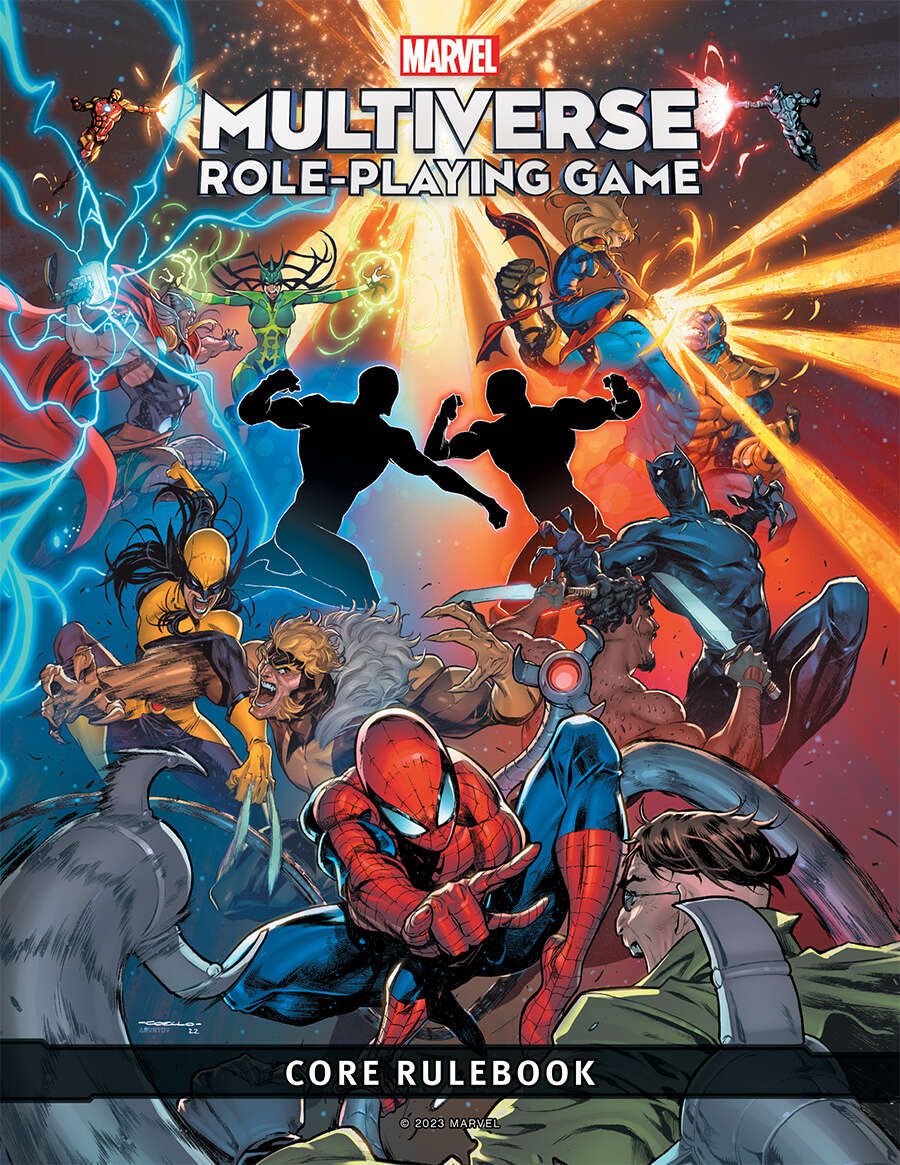
How’s It Play?
The basic system for Marvel Multiverse isn’t crazy radical since there’s only so much you can do with a d6 based system. Unlike the Year Zero system and others, though, there’s no pools involved here. For this game, you’re only ever rolling three dice. Two regular dice and a a “Marvel Die.” If you get the official set (available for $18.99 wherever fine games are sold!) the Marvel die will naturally be red with a Marvel logo where the 6 would be. If you don’t want to spring for some branded d6’s that you probably have enough of anyway, you’ll just make that third dice a different color than the others. Whenever a character needs to make a check or attack, all three dice are rolled. Most of the time, the total will be added to the relevant ability score and compared to the target to determine success or failure. But there’s a couple factors at play that can affect that outcome.
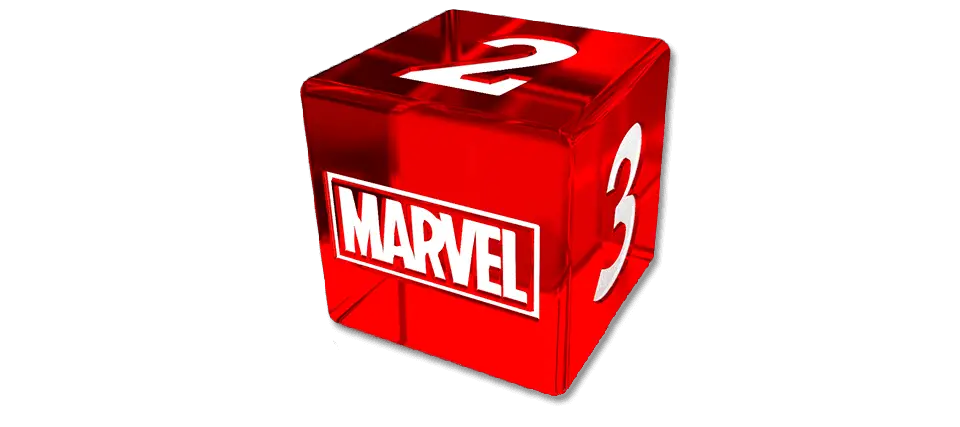
First off is that all-important Marvel die. Not only does it constantly remind you who owns everything you love, it also acts as your “crit”, or in this game a “Fantastic” roll. If your total exceeded your target, a Fantastic roll means you do what you wanted AND cause another extra effect to occur. If you get a Fantastic roll and fail, you don’t get to do what you want but there is some other effect that happens. Interestingly, it’s the player who decides what that effect is as opposed to the Narrator (though they do adjudicate if the chosen effect is allowed). Finally if a player gets a six on the two side die AND a Fantastic roll, it’s considered an automatic success no matter the target. Your rolls also might be effected by “Edges” and “Troubles,” which are story-related effects the Narrator gives out that make you reroll your worst roll, in the case of Edges, or best roll, in the case of Troubles. It’s not the world’s most complicated system but it does allow for a good amount of creativity beyond just the dice rolling.
Combat is even simpler, since defenders don’t roll anything and there’s no “to-hit” roll. Initiative, line of sight, and range all work the same as basically every other TTRPG. When you’re actually going to attack, you just roll with your chosen attack (Melee, Agility, etc) against the target’s specific defence. If you beat that value, you do your relevant damage. If it’s a fantastic roll, you do double. Other actions are fairly standard like Dodge, Escape, Grab, and move. You also get a reaction every turn, which are a little more interesting and include the classic Fastball Special, a Ram maneuver, and a “Skulk” action that lets you get up behind someone attacking someone else. It’s clear in designing combat they wanted tactics to be more important than the rolls themselves and it mostly succeeds without getting too deep into the nitty gritty like other titles have.
A Superhero Is You!
There’s two ways to play Marvel Multiverse: you either make your own character or play one of the existing Marvel heroes or villains generated in the book. And I’m pretty sure I know which most people will play but, for the sake of completion, I’ll go through both.
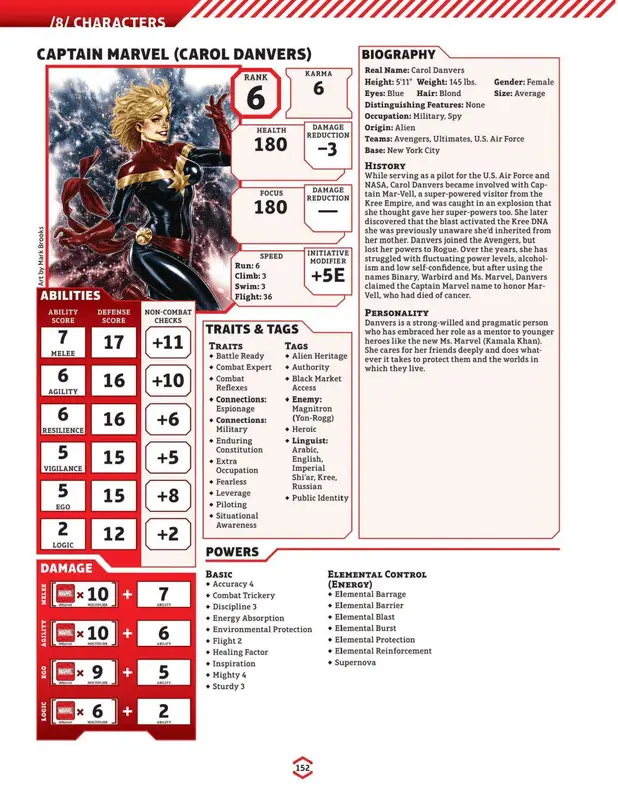
Like any great TTRPG, the ability scores spell out a word. That word, as you expect, is MARVEL: Melee, Agility, Resiliance, Ego, and Logic. Melee is close combat attack and defense, Agility governs range weapons, movement and acrobatics, Vigilance is where your Focus (willpower) and Initiative come from as well as your investigative abilities, Resilience is health and toughness, Ego is for magical abilities, charismatic work, and psychic defenses, and Logic is your Intelligence and telepathy. How you deal out your points will dictate what sort of hero you are as different scores affect your powers and abilities in combat.
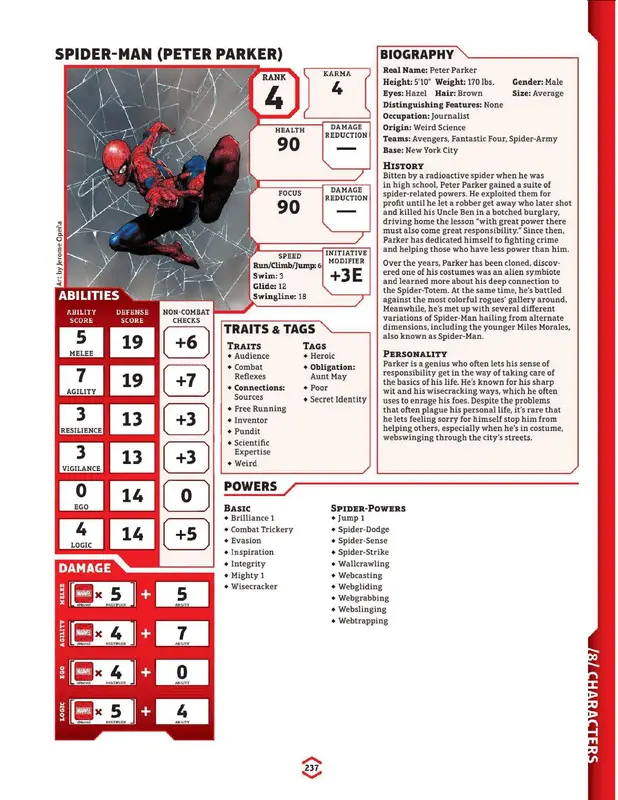
All characters get an Origin that explains their powers and an Occupation, both of which come with traits and tags that shape your abilities. Traits are similar to Feats in other games, often having useful abilities both in and out of combat. Tags are more flavorful, simple details that help your roleplay your character and move the story.
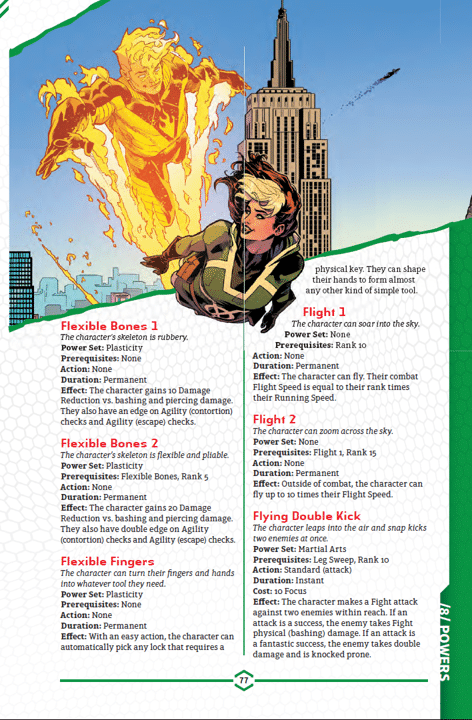
Powers are where things get interesting for the game, and it’s maybe THE most fun part to play with since it goes pretty deep. Characters get four powers per level and you can mix and match fairly freely, though you get bonuses for keeping the powers in the same “set”. There’s also “Basic Powers” that don’t belong to a set. And powers aren’t just the big flashy things like flight, energy blasts, or super strength. It can also mean you’re really good with weapons, or with battle tactics, or…just having a shield. Alright some of them are a little weird to be called “powers” but they had to give the non-supers something to work with.
MOST of the book is dedicated to the profiles of Marvel’s pre-existing characters and if I were you this is where I’d look if you want to try this game out. Character creation is a little finicky and, truth be told, you’ll probably just end up with a cheap copy of an existing hero anyway once things are all said and done. With that in mind, the heroes and villains have an incredible amount of depth and allow for a lot of really fun combinations. Want Agatha Harkness, Ronan the Accuser, and Nightcrawler to team up? Go hog wild! It reminds me of the way the Warhammer 40k TTRPG’s approach things, where you make a squad up and go at the story that way rather than fully embodying a totally new character. My main complaint here is that it just feels imbalanced with the heavy focus on these pre-gen characters compared to standard character creation.
The Verdict?
Licensed TTRPG’s are always fighting an uphill battle when it comes to breaking out of their license. And honestly if you’re not a Marvel fan, there’s better superhero RPG’s out there like Mutants and Masterminds. And the aforementioned Year Zero Engine from Free League remains, in my opinion, the gold standard for a d6 based system. Marvel Multiverse almost relies TOO heavily on its players being dedicated Marvel Zombies, not spending a ton of time on worldbuilding or setting in favor of giving you stats for all your favorite blorbos. That said if you ARE a big Marvel nerd (like me!) then this game is definitely worth checking out just because of how well fleshed out the characters are as TTRPG pre-gens. Like I said, there’s much fun to be had being able to write your own playable fanfiction. And with adventures like The Cataclysm of Kang and expansions for both X-Men and the Spider-Verse on their way there’s going to be PLENTY to dig into. Excelsior!
You can grab the Marvel Multiverse RPG and its expansions on DriveThruRPG, Amazon, Barnes & Noble, or at your FLGS, with the Core Rulebook at an MSRP of $59.99.
Images and review copy via Marvel
Have strong thoughts about this piece you need to share? Or maybe there’s something else on your mind you’re wanting to talk about with fellow Fandomentals? Head on over to our Community server to join in the conversation!

